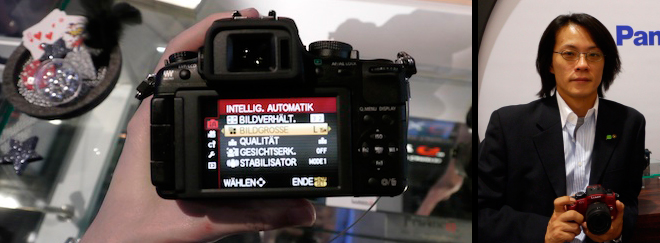Panasonic are in talks with Epson to provide cutting edge new display technology for the EVF in the GH3. The news comes from a recent interview with Panasonic’s Ichiro Kitao at the launch of the GF3. It was a change of tone from last year when Panasonic spoke of the GH2 as a niche camera. Now they say, it is a ‘flagship’ and ‘very important’.
With Sony’s A77 set to feature a 3MP OLED EVF, Panasonic are concentrating on refresh rate and resolution. To drive the faster refresh rate and a 3MP EVF, the camera will need to produce a live video feed of at least 2048 x 1536 (4:3) or 2208 x 1248 (2.8MP in 16:9) at 60fps to the viewfinder. Possibly even as high as 120fps to match the refresh rate of the panel. Modern LCDs usually refresh at 120hz (like TVs and their anti-cinematic ‘smoothing’ modes).
That leads the door open for higher than 1080p recording capabilities or at the very least 1080/60p. The GH2’s sensor already outputs this but the image processor interlaces it. If the sensor and image processor in the GH3 is fast enough to power the new EVF, it would certainly in theory be capable of 4K in 24p mode as well, although it is doubtful Panasonic will move to 4K before the standard becomes more common in consumer displays devices like TVs.
Kitao also says he doubts whether customers really want high pixel counts for stills. “If we continue to raise the resolution it becomes very difficult to offer high quality video”, citing the issue of heat build-up from so much data to process.
Panasonic admitted last year that the only reason the GH2 featured an 18MP sensor was down to marketing. If the average consumer’s lack of interest and knowledge in what they are buying negatively influences the product, that in my view is a failure of leadership and marketing on the shop floor. In fact the Japanese camera giants have done their customers a massive disservice for collectively pandering to their whims with higher megapixel counts.
The actual engineers and camera designers themselves, who come up with the goods have been vocal about the issue, but management has allowed a flaw in the open market to dictate their direction. It is the ‘tall tree’ syndrome, where the properties of one competitor causes the others to keep up at the expense of the overall forest. Eventually the trees wither and die because they are too big, and their size gain has not benefited them.
Sony for instance has spent billions of dollars on backlight illumination CMOS technology to improve image quality in low light, only for it to justify greater pixel counts so that the overall image quality improvement has been lost.
I am very excited to see what the GH3 brings, but let’s hope it goes back to 12MP and Kitao stays true to his words. First he will have to win the fight with marketing.



